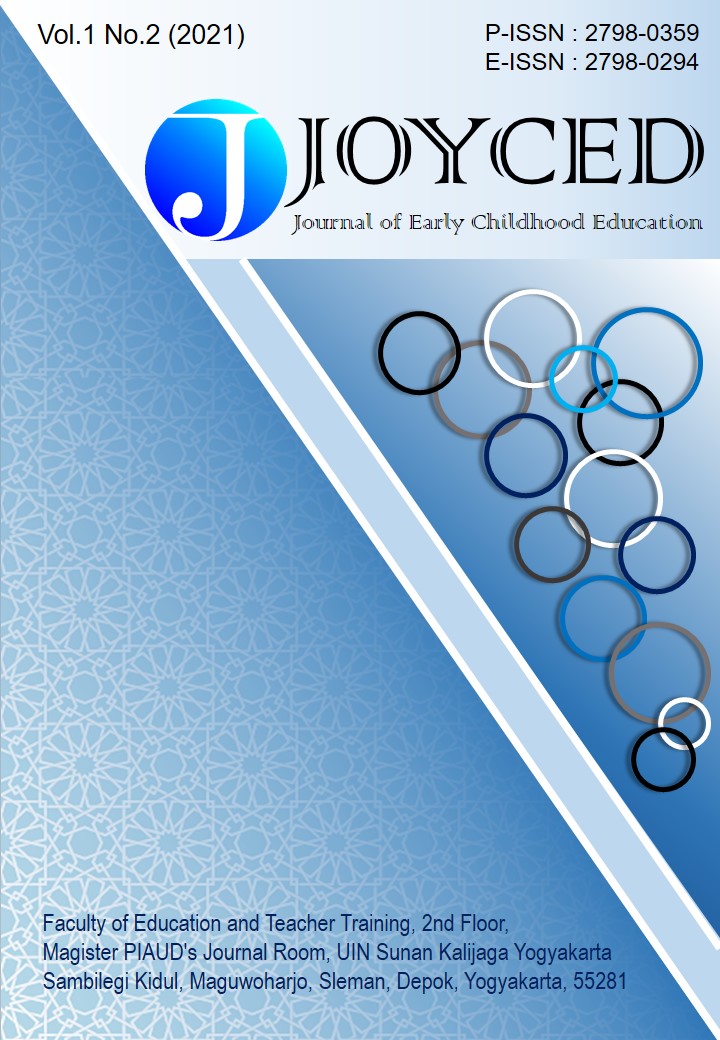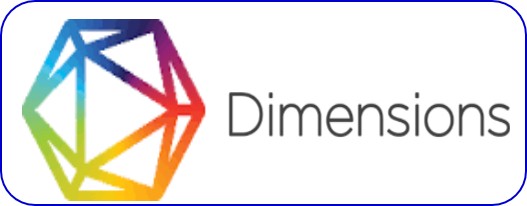Story to Improve Language Abilities of Early Children
DOI:
https://doi.org/10.14421/joyced.2021.12-01Keywords:
Storytelling, Improve Capabilities, Language Ability, Children, Early ChildhoodAbstract
Language skills in PAUD Terpadu Mutiara Yogyakarta children are still low. This matter is caused by less attractive and varied educational procedures and media. The use of exciting techniques such as telling is expected to improve children's language skills. This research aims: to identify the skills in telling children in improving the language skills of children PAUD Terpadu Mutiara Yogyakarta; to recognize the increase in language skills of children in PAUD Terpadu Mutiara Yogyakarta through telling. This research's procedure involves action research, which consists of 2 cycles, the first cycle of 8 actions and the second cycle of 3 steps. The study subjects were children in group B, with 16 children consisting of 5 boys and 11 girls. Methods of collecting information through observation, interviews, and documentation. The method of information analysis was tried descriptively, qualitatively, and quantitatively. The action's success criterion is if the average class score in improving language skills reaches 75%. The research results show that: the media implementation process includes three stages, namely preparation, implementation of activities, and assessment; in Cycle I, it increased from the results of pre-action by 27% to 36%, and in Cycle II, it increased to 75%. So it can be concluded that the implementation of telling can improve PAUD Terpadu Mutiara Yogyakarta children's language skills.
Downloads
References
Aramaki, E., Shikata, S., Miyabe, M., & Kinoshita, A. (2016). Vocabulary size in speech May Be an early indicator of cognitive impairment. PLoS ONE, 11(5), 1–14. https://doi.org/10.1371/journal.pone.0155195
Bowers, L. M., Dostal, H., Wolbers, K. A., & Graham, S. C. (2018). The Assessment of Written Phrasal Constructs and Grammar of Deaf and Hard of Hearing Students with Varying Expressive Language Abilities. Education Research International, 2018. https://doi.org/10.1155/2018/2139626
Caciolo, C., Alfieri, P., Piccini, G., Digilio, M. C., Lepri, F. R., Tartaglia, M., Menghini, D., & Vicari, S. (2018). Neurobehavioral features in individuals with Kabuki syndrome. Molecular Genetics and Genomic Medicine, 6(3), 322–331. https://doi.org/10.1002/mgg3.348
Capobianco, M., & Cerniglia, L. (2017). Early language development in preterm children without neurological damage: A longitudinal study. F1000Research, 6, 1–8. https://doi.org/10.12688/f1000research.13314.1
Chen, J. J., & Ren, Y. (2019). Relationships Between Home-Related Factors and Bilingual Abilities: A Study of Chinese–English Dual Language Learners from Immigrant, Low-Income Backgrounds. Early Childhood Education Journal, 47(4), 381–393. https://doi.org/10.1007/s10643-019-00941-9
Christiner, M., & Reiterer, S. M. (2018). Early influence of musical abilities and working memory on speech imitation abilities: Study with pre-school children. Brain Sciences, 8(9). https://doi.org/10.3390/brainsci8090169
Dolscheid, S., & Penke, M. (2018). Quantifier comprehension is linked to linguistic rather than to numerical skills. Evidence from children with down syndrome and williams syndrome. PLoS ONE, 13(6), 1–16. https://doi.org/10.1371/journal.pone.0199743
Friedman, L., Sterling, A., DaWalt, L. S., & Mailick, M. R. (2019). Conversational Language Is a Predictor of Vocational Independence and Friendships in Adults with ASD. Journal of Autism and Developmental Disorders, 49(10), 4294–4305. https://doi.org/10.1007/s10803-019-04147-1
Hadley, P. A. (2020). Exploring sentence diversity at the boundary of typical and impaired language abilities. Journal of Speech, Language, and Hearing Research, 63(10), 3236–3251. https://doi.org/10.1044/2020_JSLHR-20-00031
Hilvert, E., Sterling, A., Haebig, E., & Friedman, L. (2020). Expressive language abilities of boys with idiopathic autism spectrum disorder and boys with fragile X syndrome + autism spectrum disorder: Cross-context comparisons. Autism and Developmental Language Impairments, 5. https://doi.org/10.1177/2396941520912118
Kaushanskaya, M., Park, J. S., Gangopadhyay, I., Davidson, M. M., & Weismer, S. E. (2017). The relationship between executive functions and language abilities in children: A latent variables approach. Journal of Speech, Language, and Hearing Research, 60(4), 912–923. https://doi.org/10.1044/2016_JSLHR-L-15-0310
Kwok, E. Y. L., Joanisse, M. F., Archibald, L. M. D., & Cardy, J. O. (2018). Immature auditory evoked potentials in children with moderate–severe developmental language disorder. Journal of Speech, Language, and Hearing Research, 61(7), 1718–1730. https://doi.org/10.1044/2018_JSLHR-L-17-0420
Lebel, C., MacMaster, F. P., & Dewey, D. (2016). Brain metabolite levels and language abilities in preschool children. Brain and Behavior, 6(12), 3–4. https://doi.org/10.1002/brb3.623
Li, L., & Tan, C. L. (2016). Home Literacy Environment and its Influence on Singaporean Children’s Chinese Oral and Written Language Abilities. Early Childhood Education Journal, 44(4), 381–387. https://doi.org/10.1007/s10643-015-0723-4
Madden, E. B., Conway, T., Henry, M. L., Spencer, K. A., Yorkston, K. M., & Kendall, D. L. (2018). The relationship between non-orthographic language abilities and reading performance in chronic aphasia: An exploration of the primary systems hypothesis. Journal of Speech, Language, and Hearing Research, 61(12), 3038–3054. https://doi.org/10.1044/2018_JSLHR-L-18-0058
Miller, M. K., Calandruccio, L., Buss, E., McCreery, R. W., Oleson, J., Rodriguez, B., & Leibold, L. J. (2019). Masked english speech recognition performance in younger and older Spanish–english bilingual and english monolingual children. Journal of Speech, Language, and Hearing Research, 62(12), 4578–4591. https://doi.org/10.1044/2019_JSLHR-19-00059
Nittrouer, S., Lowenstein, J. H., & Antonelli, J. (2020). Parental language input to children with hearing loss: Does it matter in the end? Journal of Speech, Language, and Hearing Research, 63(1), 234–258. https://doi.org/10.1044/2019_JSLHR-19-00123
Peng, Z. E., & Wang, L. M. (2019). Listening effort by native and nonnative listeners due to noise, reverberation, and talker foreign accent during english speech perception. Journal of Speech, Language, and Hearing Research, 62(4), 1068–1081. https://doi.org/10.1044/2018_JSLHR-H-17-0423
Tambyraja, S. R., Rhoad-Drogalis, A., Khan, K. S., Justice, L. M., & Sawyer, B. E. (2019). Inattentiveness and Language Abilities in Preschoolers: A Latent Profile Analysis. Journal of Abnormal Child Psychology, 47(2), 245–257. https://doi.org/10.1007/s10802-018-0451-5
Vadakalur Elumalai, K. (2019). Teacher Constructed Corrective Feedback Enhancing Students Writing Skills in EFL Classroom. Advances in Language and Literary Studies, 10(5), 103. https://doi.org/10.7575/aiac.alls.v.10n.5p.103
Venker, C. E., Edwards, J., Saffran, J. R., & Ellis Weismer, S. (2019). Thinking Ahead: Incremental Language Processing is Associated with Receptive Language Abilities in Preschoolers with Autism Spectrum Disorder. Journal of Autism and Developmental Disorders, 49(3), 1011–1023. https://doi.org/10.1007/s10803-018-3778-4
Weismer, S. E., Kaushanskaya, M., Larson, C., Mathée, J., & Bolt, D. (2018). Executive function skills in school-age children with autism spectrum disorder: Association with language abilities. Journal of Speech, Language, and Hearing Research, 61(11), 2641–2658. https://doi.org/10.1044/2018_JSLHR-L-RSAUT-18-0026
Zhang, J., Fan, X., Cheung, S. K., Meng, Y., Cai, Z., & Hu, B. Y. (2017). The role of early language abilities on math skills among Chinese children. PLoS ONE, 12(7), 1–15. https://doi.org/10.1371/journal.pone.0181074
Zimmerman, E. (2018). Do infants born very premature and who have very low birth weight catch up with their full term peers in their language abilities by early school age? Journal of Speech, Language, and Hearing Research, 61(1), 53–65. https://doi.org/10.1044/2017_JSLHR-L-16-0150






.png)











